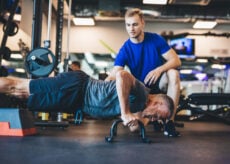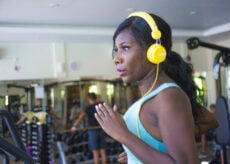The 8-Week Beginner Workout Plan for All Ages

Are you ready to start exercising but just don’t know where to start? Try this 8-Week Beginner Workout Plan to help you ease into cardiovascular exercise, flexibility and mobility plans, and resistance training. With this trifecta working in your favor, you’ll be surprised what you can achieve in just 8 short weeks!
The Fitness Trifecta
There’s exercise and then there’s strategic exercise. That’s what this plan is all about—getting the most you can out of the shortest amount of time and building a solid foundation so you can continue to improve your physique in the long run.
What does it take? Getting the best results means maximizing your time working out and in the gym. And, you have to attack from all angles if you want to improve overall health and fitness. That means you’ll want to include cardio (aerobic type of training) to condition your heart and lungs; flexibility and mobility exercises so you stay (or get) limber, prevent injury, and enjoy more day-to-day functionality; and resistance training to strengthen that flexible, well-conditioned body.
Step 1: The Cardio Plan
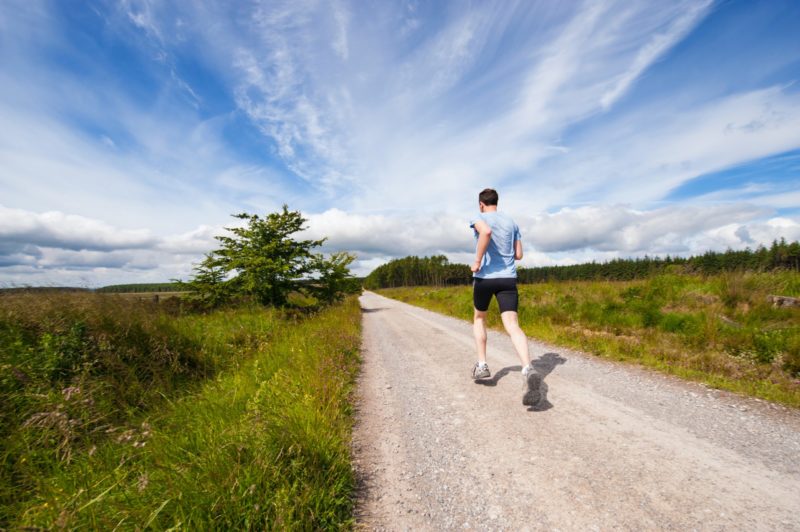
Why is doing cardiovascular exercise important? Cardiovascular disease is one of the leading causes of illness and death. A sedentary lifestyle is a huge contributor to this issue. But, the good news is that a lot of the damage done by lifestyle choices can be undone through a regular exercise plan.
The World Health Organization recommends a minimum of 150 minutes of aerobic activity a week. Or, if you want to go all-out with HIIT training (high-intensity interval training), you can do 75 minutes of this type of cardio instead. A great idea is to combine the two for maximum benefit.
Warm-Up—always start with some gentle movement to ease yourself into your exercise session. Try a five-minute slow walk to get the blood moving before going all-out.
The Plan—start slowly! If you’ve been sedentary for months or even years or you’re just starting out, it’s a good idea to start with 10 – 15 minutes of walking, 3 times a week. Each week, add 5 minutes to your cardio sessions until you’re up to 30 minutes, 3 – 5 times a week.
Add in HIIT—if you want to mix in some HIIT training with the steady state-cardio for max fat burning and conditioning, try making one to two of your three to five sessions a week a HIIT day. Go for a 5-minute warmup followed by interval training: 45 seconds of slower movement followed by 15-second bursts of all-out activity for one round. Start with five rounds and work your way up from there.
The Cooldown—always end your cardio sessions with a five-minute gentle cool down, like a slow, leisurely walk.
Step 2: The Flexibility and Mobility Plan
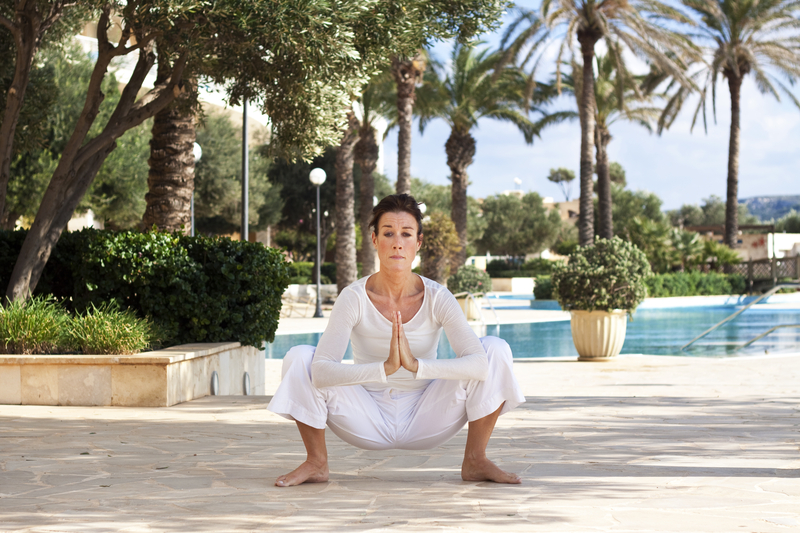
Flexibility equals youthfulness, less chance of falling, and more self-sufficient living. Getting more mobile and flexible will require time and commitment. Strive to work on stretching and balancing exercises three days a week. If you’re also doing cardio or weight training that day, do these exercises after your other training when your body is warm and your muscles more pliable. Try these exercises or choose your own:
Standing Roll Downs—start by standing with your feet hip-width apart. Keep your arms slightly in front of you. Bend forward at the hips while letting your head, neck, and shoulders roll forward as you bring your upper body toward the ground. Let yourself hang in that position for a few moments before rolling back up to the start.
Kneeling Cobra—start on your hands and knees. Push your hips back and allow your arms, shoulders, chest, and lower back to stretch fully, then push your hips forward, straightening your knees until you feel a good stretch through your abdominals. Repeat.
Yoga Squat—this squat will help open up stiff hips and loosen up your lower back, knees, hamstrings, and ankles. Start with a wide stance with your feet and knees pointed outward. Bring your palms together in front of you and slowly lower yourself down into a squat position. While in this position, place your elbows against your inner knees and push out to help widen your stance. Hold this position for 10 seconds and then push back up through your heels to standing.
Tree Pose—this pose will help you improve your balancing abilities. Start slowly and support yourself as you work your way up to doing this without support and for longer periods of time. Start with both feet firmly planted on the ground with your feet facing forward. Bring your hands up over your head, pressing your palms together. Place your weight on your right foot. Bring your left knee out to your side and slide your left foot up the inside of your right leg until your foot is in a comfortable position resting on your leg, either above your knee or below your knee (but avoid placing it directly on the knee, which can stress the joint). Make sure your body is straight, not twisted. Hold this pose for a count of five and then slide your foot back down the inside of your leg until you can place it back on the ground. Repeat on the opposite side.
Towel Stretches—this stretch is more accessible when working with a small towel. Stand with your feet about hip-width apart and grab one end of the towel in your right hand. Bring your right arm up while bending at the elbow, allowing the towel to hang down your mid-back. Then, place your left arm behind your back, and bend it upward so the back of your hand can slide up your back and grab the opposite end of the towel. (As your shoulders get more flexible, you may be able to just use your hands without a towel.)
With your right arm, gently pull upward on the towel to move your left arm higher on your back. Be easy on yourself as you get more flexible and don’t force it. Get a good stretch through your left shoulder and hold that position before releasing the towel and moving back to the start. Repeat on the opposite side.
Crossover Glute Bridges—these stretches are easy and can help loosen up tight hips and glutes. Begin by lying on your back with your knees bent and your hands by your sides. Take your right leg, bend at the knee to bring your ankle across your body, placing it against your left thigh, just above the knee. Press your hands, palms down, into the ground and simultaneously lift your hips off the ground and upward while squeezing your buttocks (glutes) as you go through the movement. Pause for a count of three and return to start. Do the same movement but switch legs to get a good stretch in the left hip. Repeat.
Leg Swings—start by standing next to a stable surface and balance there, using your left hand for support. With your leg straight, lift your right foot slightly off the ground and swing your leg all the way to the front and then all the way to the back. Perform 15 swings in each direction. Repeat on the opposite side. Then, move your body to face the stable surface, bracing yourself with both hands for balance and swing your right leg side to side in front of your body. Do 15 reps and then switch to the opposite side and repeat.
Step 3: The Resistance Training Plan

It’s all about the muscle mass. Muscle tissue is metabolically active, meaning that muscle needs calories to survive. The more muscle tissue you have translates to the more calories you can eat and not put on body fat. Or, if you’re trying to lose weight, more muscle tissue means easier weight loss.
According to the World Health Organization, muscle-strengthening exercises should be performed at least twice a week, ideally more often. You’ll want to ensure that you work your entire body to prevent imbalances and injury. Work the major muscle groups at least once a week (or more). Don’t work the same muscle two days in a row. And if you’re still extremely sore from your last workout, take another day in-between workouts for that body part.
Your main muscle groups are:
- Chest
- Shoulders
- Triceps
- Back
- Biceps
- Legs/Calves
- Abdominals
If you’re a beginner, it’s a great idea to start with an upper and lower body workout plan. This means on day one, you’ll work your entire upper body and on day two, your entire lower body. This will naturally give you a day in-between working body parts for sufficient rest. Start with this workout once or twice a week, depending on your fitness level.
The Resistance Training Timing
Week 1—pick 1 exercise per body part and do 12 – 15 repetitions during week one. The weight should be somewhat light but a little challenging on the last few reps.
Weeks 2 & 3—do 2 sets of 12 – 15 repetitions per body part.
Weeks 4 & 5—pick 2 exercises per body part and do 1 set of 12 – 15 repetitions per exercise.
Week 6—start using weight that is a little heavier and more challenging for you. You should be able to do only about 10 – 12 repetitions per set. Do two sets of each exercise.
Weeks 7 & 8—pick 2 – 3 exercises per body part. Do three sets of each exercise. The first set, do 12 – 15 reps, go a little heavier for set #2 and aim for 10 – 12 reps. On your third set, go even heavier so you can only do about 8 – 10 repetitions before you can’t do any more.
Upper Body Workouts
Shoulders
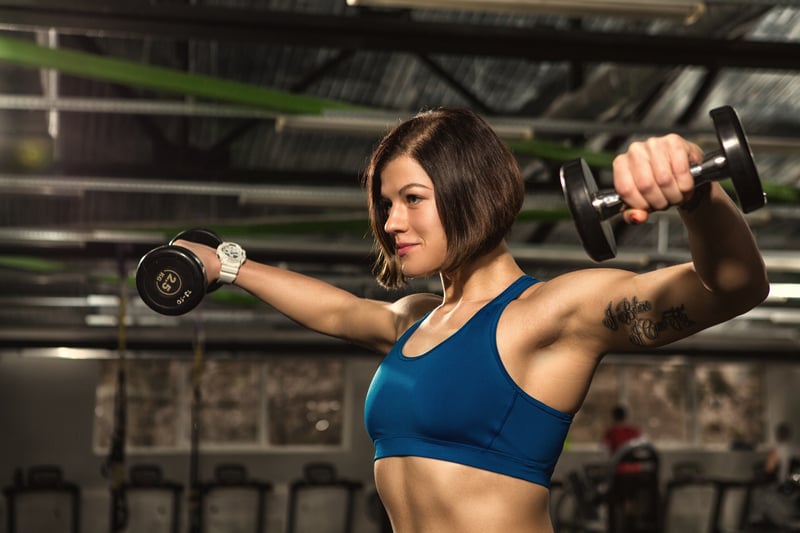
Dumbbell Side Lateral Raises—start by holding a dumbbell in each hand with your arms straight by your sides, palms facing your body. Keep your feet about hip-width apart and lift your arms up and out to the sides while keeping a slight bend in the elbows. Move upward until your arms are parallel with the floor and then slowly lower to return to the starting position. Repeat.
Shoulder Presses—this can be done on a gym machine or while sitting on a bench with dumbbells. For the dumbbell shoulder press version, sit on a bench with the back up so you can lean your upper body against it as you go through the movement. With a dumbbell in each hand, bend your arms to bring them up until they are even with your shoulders. Next, push your arms up and straighten your elbows until the ends of the dumbbells are able to touch over your head. Slowly lower the dumbbells back down to the starting position. Repeat.
Triceps
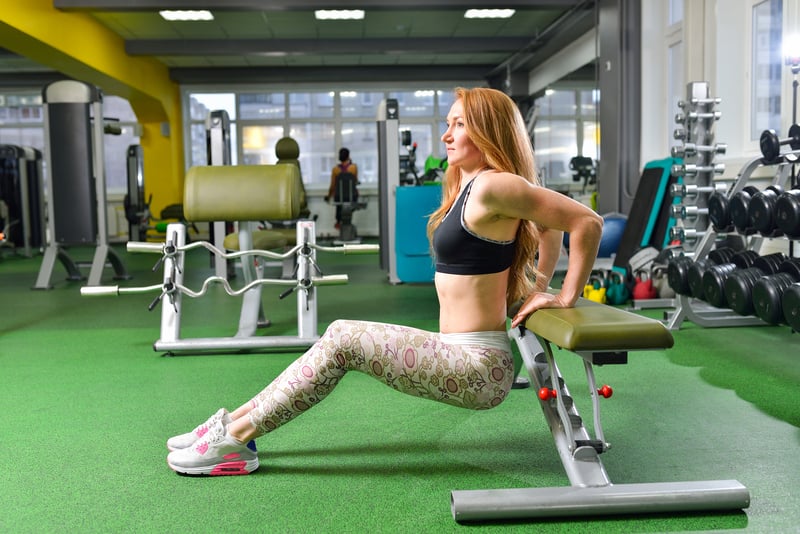
Bench Dips—sit on the edge of a bench and place your hands on the bench next to your hips. Kick your legs out straight in front of you and keep your heels on the ground. Slide your hips off the bench as you slowly lower your upper body toward the floor. At the same time, bend your arms until your upper arm is parallel with the floor. Push your body back up until your arms are straight while squeezing your triceps. Repeat.
BREAKING: US Doctor: “Eating This Every Day Can Snap You into Ketosis”
Dumbbell Triceps Kickback—bend over with your left knee and left palm on a bench and a dumbbell in your right hand. Bend your right arm so your upper arm is parallel with the floor. Squeeze your triceps muscles as you straighten your arm out and up behind you. Hold the squeeze for a count of five and then lower the weight back to start. Repeat on the opposite side.
Biceps
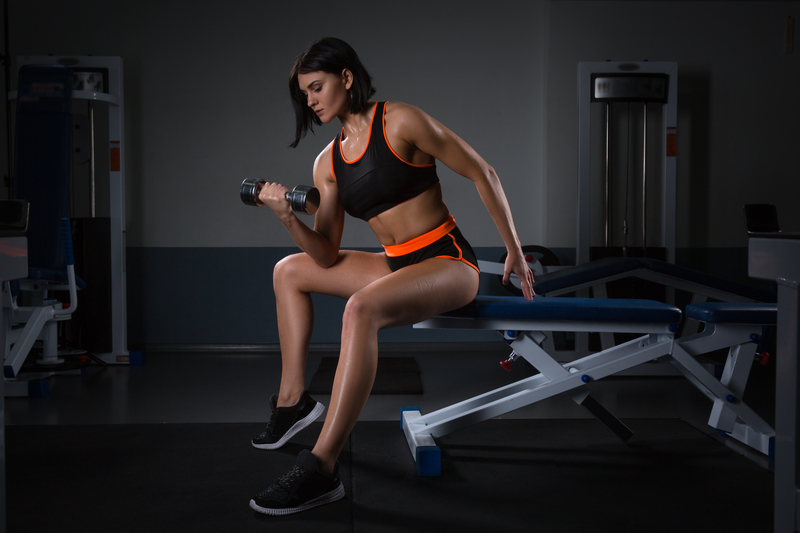
Hammer Curls—start with your feet about hip-width apart and hold a dumbbell in each hand at your sides, palms facing your body. Next, bend your elbows to raise the front end of each dumbbell toward your shoulders. Slowly lower the dumbbells to the starting position and repeat.
Biceps Concentration Curl—start by sitting on a bench with your feet wide apart. Place a dumbbell in your right hand with your palm facing upward with your elbow on your knee. Straighten your arm as you lower the weight down toward the floor. Next, bring the weight back up to the starting position by squeezing your biceps muscles to complete one rep. Do 10 repetitions on each side.
Chest
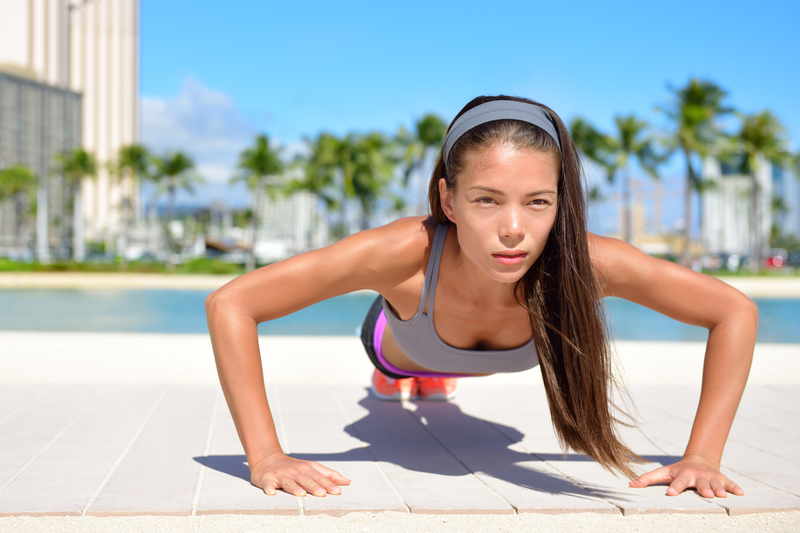
Dumbbell Press—with a dumbbell in each hand, lie on your back on a bench with your arms straight out and above you. Bend at the elbows and lower the weight until your upper arms are parallel with the floor and the dumbbells are approximately next to your shoulders. Pause and push the weight back up to the starting position and repeat.
Dumbbell Flyes—use a gym machine or lie on a bench. Hold a dumbbell in each hand with your arms out straight above your head and the dumbbell ends touching each other (palms facing each other). Slowly extend and lower your arms out to your sides until they are parallel with the ground (with straight arms and a slight bend in the elbow). Raise your arms back to the center and repeat.
Pushups—do these on your knees if you’re a beginner or not able to perform a regular pushup. Start in a plank position with your arms directly below your shoulders and a little wider than shoulder-width apart. Lower your body by bending at the elbows and lowering your chest to the ground. Keep your back and glutes in a straight line as you move and then push back up until your arms are straight. Repeat.
Back

Lat Pulldown—sit on a pulldown machine and grab the bar above you with both hands. Pull the bar down in a smooth motion toward the front of your chest as you bring your elbows toward each other behind your back. Control the weight as it moves back upward until your arms are straight. Repeat.
Seated Cable Row—sit on a seated row machine, with your legs straight and lean forward to grab the handles. Sit with your back straight and pull your elbows straight back until your hands are at your waist. Allow the weight to move back toward the start of the exercise slowly until your arms are fully straightened. Repeat.
Assisted Pullups—you can do normal pullups if you can—most people aren’t strong enough. Fortunately, most gyms have an assisted pullup machine to help you build up to a full pullup. Adjust the weight so you can do a pullup with your knees resting on the pad, so that it’s still challenging. Perform the pullup motion as the platform moves up and down with you.
Lower Body Workout
Abs
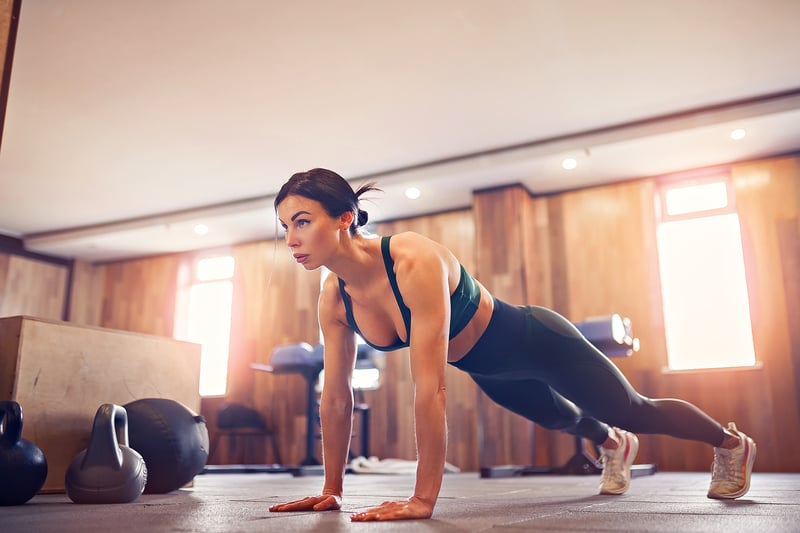
Plank—start on your hands and knees in pushup position with palms down and hands aligned under your shoulders. Keeping your back straight, hold this position for 10 – 30 seconds at a time. Repeat.
Open Leg V Balance—start by sitting and bringing your heels to your center. Next, grab your ankles and straighten your legs until they are in a V shape and your body is balanced at about a 45-degree angle. Hold this position for a count of three and return to the start. Repeat.
Legs
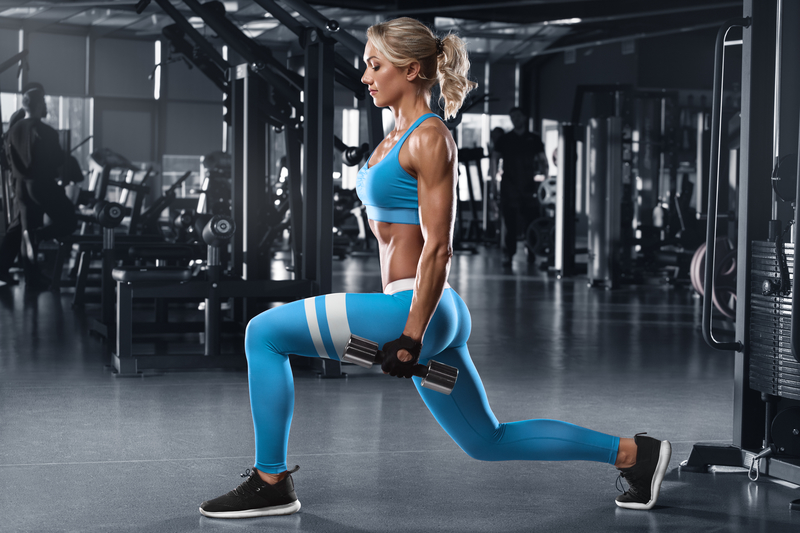
Wall squats—begin by standing against the wall with your feet about a couple of feet in front of you, so when you are in the full squat position, your knees are directly over your ankles. Keep your back and hips touching the wall. Next, slowly slide your hips down the wall as you bend at the knees until your thighs are parallel with the ground. Hold this squat position as you count to ten and then straighten your legs to slide back up the wall to complete one repetition.
Walking lunges—begin by standing with your hands together in front of you at chest level with your feet about hip-width apart. Take a giant step forward with your right leg as you bend at the knee. Move forward by bending your knee until your right thigh is parallel with the ground. Push through your left heel to move yourself forward and back up to a standing position. Repeat on the opposite leg to complete one repetition.
Glute Thrust—start by lying on your back with your shoulders on the floor or on a bench with your hands next to your hips, knees bent, and feet flat on the floor. Next, thrust your hips up as high as you can. Squeeze your glutes at the top of this movement and then slowly return to the starting position. Repeat.
Leg press—place your feet on the pad with your knees bent. Release the safety catch and push up through your heels to straighten until your knees are straight but not locked out. Once they are straight, lower the weight back down slowly until your knees are fully bent and repeat. Each set, try placing your feet in different positions on the pad to hit your legs from multiple angles.
Calves
Calve Raises—hold a dumbbell in each hand and raise up to stand on your toes. Raise and lower yourself by lifting and lowering your heels. Repeat.
Seated Calf Press—sit on a seated calf machine with your knees under the pad and your toes on the platform. Raise your heels to lift the weight and then lower them past the platform to feel a good stretch in the calves. Repeat.
You can find all of these exercises and many more online if you search. You’ll find additional exercises, variations on exercise, tutorials, and videos on how to perform the exercises properly. Whether you’re working out two days a week or five, this program will help you get into a good exercise routine and give you the basics to build a lasting program for fitness on.






 7 Signs Your Body is Seriously Low on Collagen (not just wrinkles)
7 Signs Your Body is Seriously Low on Collagen (not just wrinkles) Health Expert: "Turmeric Doesn't Work (unless...)"
Health Expert: "Turmeric Doesn't Work (unless...)" 3 Warning Signs Your Probiotic Supplement is a Total Waste
3 Warning Signs Your Probiotic Supplement is a Total Waste